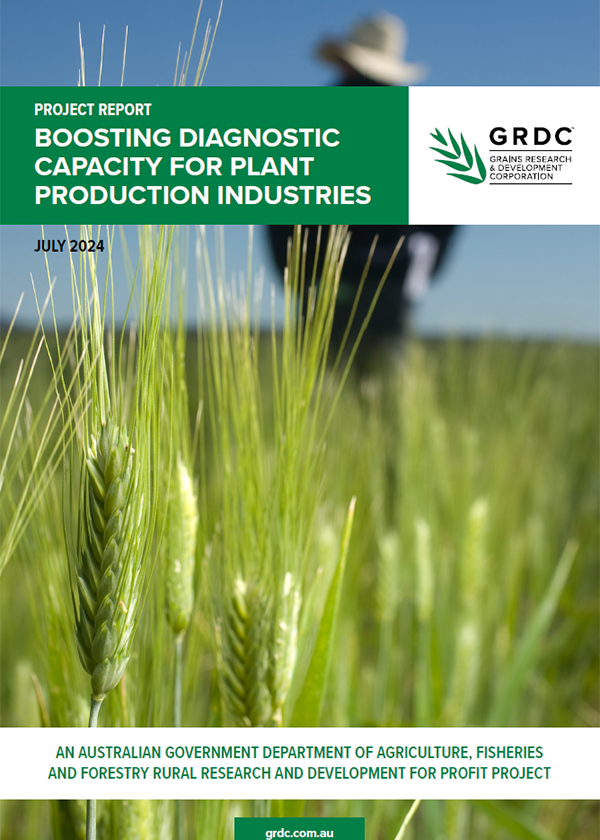Boosting diagnostic capacity for plant production industries - Using Xanthomonas as a model organism for increasing bacterial capacity
Investment
Boosting diagnostic capacity for plant production industries - Using Xanthomonas as a model organism for increasing bacterial capacity
The project will focus on the two themes 'Diagnostic Capacity Building' and 'Enhanced Diagnostic Tools'.
Diagnostic Capacity Building will be addressed in two ways: Firstly, this project will help establish our plant bacterial pathologist network in Australia through the State Diagnostic laboratories and extend this network to New Zealand (MPI and PFR). This network is working together on the identification of suspect exotics and through collaborative research projects. As part of this network establishment and capability building, we will be testing the National Diagnostic Protocols (NDP's) that are proposed for development in this project. This will enhance the bacterial diagnostic capabilities and capacity within Australia and New Zealand for exotic Xanthomonads.
Secondly, diagnostic capacity building will be achieved through increased knowledge of what endemic Xanthomonads we have in Australia by the correct identification and naming of our historical collections. NSW DPI has a collection of 800+ Xanthomonas isolates, all of which have recently been genome sequenced. These genomes will be analysed and the pathogens identity will be updated in the Australian Plant Pest Database (APPD). This information will provide both a chronological and geographic dataset of what Xanthomonads have been identified in Australia. We can use this history to quickly determine if a suspect pathogen is a new incursion, an endemic Xanthomonad in a new host, or an endemic pathogen.
The second theme 'Enhanced Diagnostic Tools', will be addressed in a number of ways. This project proposes to use subsets of the 800+ whole genome sequences for the development of genome-informed diagnostic tools. This will allow for the development of molecular assays for both the laboratory and in-field. The target bacteria for this work includes: X. citri subsp malveacearum, the causal agent of bacterial blight of cotton (NSW DPI), X. axonopodis pv alli (Xaa), the causal agent of Xanthomonas Leaf Blight of Onion (Qld) and Xanthomonas fragariae, the causal agent of Angular Leaf Spot of Strawberries (DJRP). These pathogens are all on the Australian High Priority Pest list and do not have existing National Diagnostic Protocols.
In addition, we will use a subset of the genome sequences for the development of a core/whole genome multilocus sequence analysis tool (cg/wgMLST), which can be used to trace Xanthomonad incursions and outbreaks. The aim is to use the genomes for the development of a cg/wgMLST scheme, initially targeting the Xanthomonas citri group and then the Xanthomonas campestris group. These groups of Xanthomonad pathogens are ideal as we have numerous active endemics in Australia, including X. campestris and X. citri subsp mangiferaindicae, as well as publicly available Xanthomonad genomes of important exotics. A cg/wgMLST scheme for X. campestris and X. citri will be used as a proof of concept for the development of this typing scheme and identification of potential diagnostic targets.
This project will also investigate the potential for using technologies such as the MinION for direct plant assays. This part of the work will focus primarily on Xanthomonas citri subsp malvacearum (Addressed by the PFR NZ team).
- Project start date:
- 01/04/2020
- Project end date:
- 25/06/2023
- Crop type:
-
- All Crops
- Organisation
- [NSW] Department of Primary Industries and Regional Development
- Region:
- North, South, West
- Project status
-
Completed
GRDC News
Five-year investment delivers enhanced biosecurity capability
05 Dec 2024
A comprehensive step-by-step guide to sustainable pest management throughout the crop growing season is now...
Resources

Boosting diagnostic capacity for plant production industries - GRDC
An Australian Government Department of Agriculture, Fisheries and Forestry Rural Research and Development for profit project.
